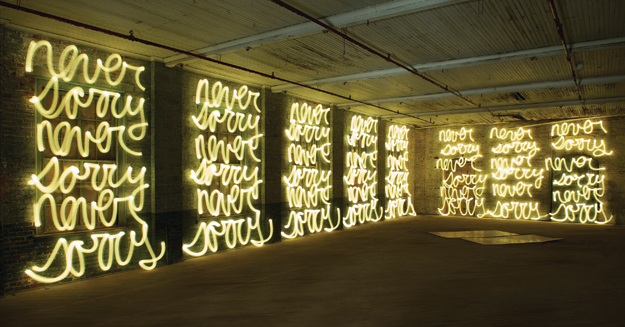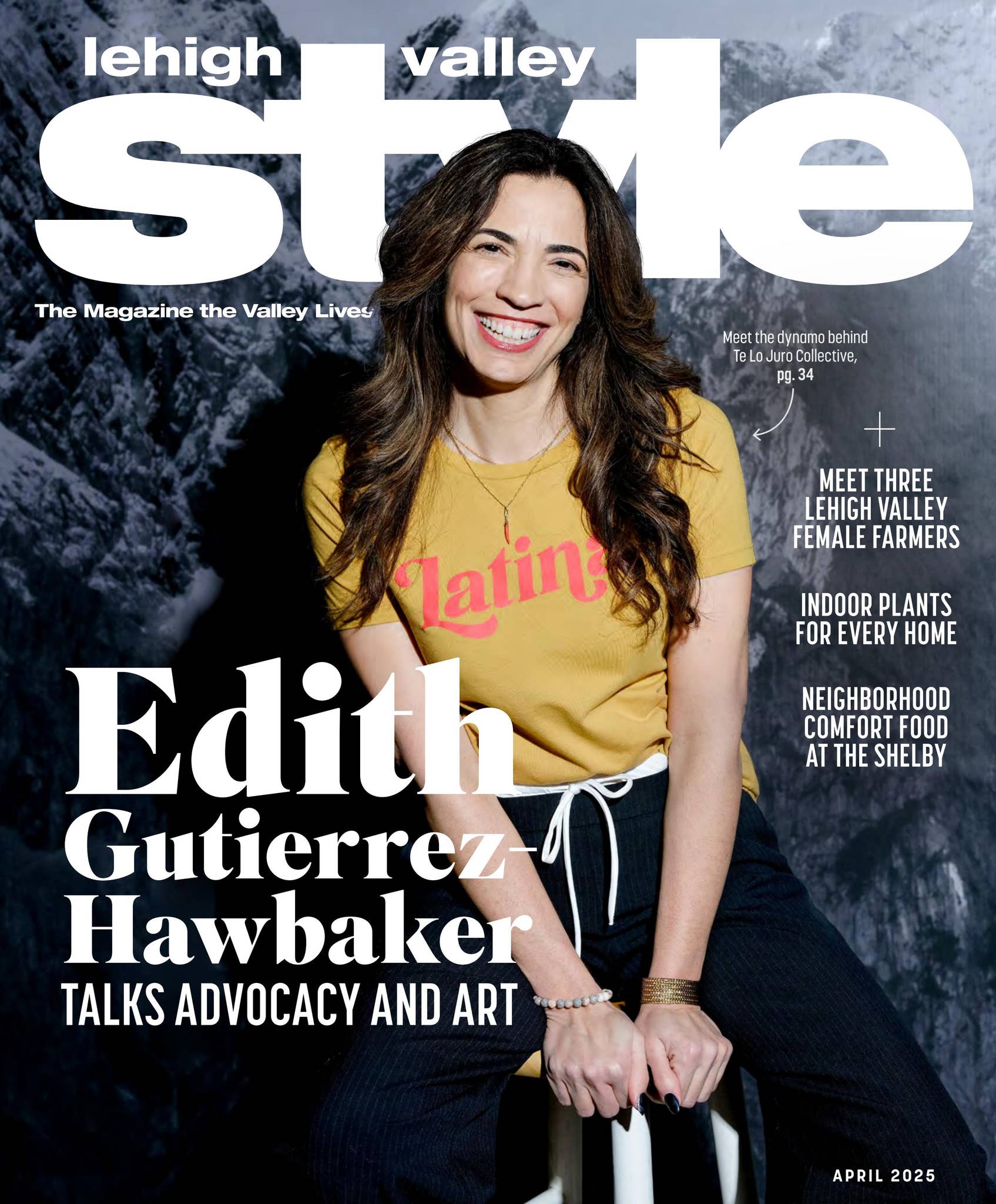
Vicki DaSilva of Allentown is one of the world's most prolific pioneers of light painting and light graffiti. The dynamic luminous shapes she creates cleverly explore a fascinating frontier where installation, performance, painting, sculpture and intervention art converge in a singular spectacular photograph. She bears the distinction of being the first artist to make a text-based light graffiti photographic work in 1980 entitled “Cash.”
DaSilva engages in the nocturnal act of creating these pieces with the land, air and manmade structures as a canvas on which to construct her light designs. She makes these images live on location by drawing with fluorescent lamps. Her movements are recorded with single frame time-lapse photography. Her idiosyncratic ideas, formed privately, remain invisible even while she executes them publicly. They only enter the world of shared perception in the form of DaSilva's stunning finished photograph. Unlike many others working in this field, she never employs post-digital manipulation.
She makes these images live on location by drawing with fluorescent lamps.
Her early light graffiti pieces were text-based forms of legal protest or playful cultural comments. They also manifested as funky febrile marks vibrantly punctuating a wide range of environments. These are always environmentally friendly creations in which no carbon footprint is left behind. She stays highly mobile by carrying the compact fluorescent lamps and a battery pack in a backpack. This frees her up to work just about anywhere.

For the walking pieces, DaSilva holds the lamp vertically and walks with it facing the camera to produce the light drawing. Her “Light Tartans” series was created by assembling a 100-foot track system on site at Fountain Park in Allentown. The lamp was moved manually along the track on a wheeled apparatus. The track was then repositioned and the process repeated to realize the vivid patterns.
To achieve the wonderful hues in her art, DaSilva cuts up cellophane color photo gels and manually places them directly onto the lamps. This gives her endless flexibility in executing complex or quirky patterns.
A teacher can be a fantastic conduit for helping a student connect with their destiny. While attending William Allen High School, DaSilva interfaced with one such enlightened art instructor, James Musselman. Her encounter with this perceptive man changed the course of her life.
She first began doing light graffiti after enrolling in a photography class.
DaSilva spent copious amounts of time in the high school art room exploring various methods of art production. Although deeply engaged, she had no plans to further her education. Musselman knew she possessed unrealized creative potential. He inquired where she was going to attend college. She replied, “I have no plans to go to college.” He asked her if she wanted to study art and if she would like to go to Kutztown University. She said yes. Musselman made a life-altering phone call that got her into Kutztown.
At the university she studied fine art with James Carroll, founder and director of the New Arts program at Kutztown. He kept a stream of amazing artists flowing in from New York City. While DaSilva was already hooked on photography, she was greatly influenced by the diversity of mediums and techniques masterfully employed by these visiting innovators.
She first began doing light graffiti after enrolling in a photography class. The work that initially captivated her was time-based photographs that captured movement of light. Some of these were scientific studies that dated back to the 1890s. Additionally, she saw the images of Picasso creating light paintings from 1949 and the wonderful alchemy achieved in the pictures of Man Ray. It occurred to her that no one had taken this genre and spent a whole career pushing the envelope to see where it leads. DaSilva was determined to travel that uncharted path.

“Roddies Rock” by Vicki DaSilva
Although she was imbibing a lot of fresh ideas at school and was also an exceptional sketch artist (examples hanging on the wall of her Allentown studio are phenomenal!), DaSilva was getting bored with her general education requirements. Her sights were on New York City and all the explosively creative '80s had to offer a burgeoning artist.
At the start of her junior year she landed an internship with the wildly interesting artist, Joan Jonas. This encounter propelled her into one of the most exciting and influential art scenes in the city's history. Jonas is an inspired performance and video artist, filmmaker, draughtswoman, printmaker and sculptor. She also ran with a stellar crowd, which brought DaSilva into contact with Spalding Gray, Robert Frank, Kiki Smith, Donald Judd, June Leaf and Nam June Paik. This exposure became a catalyst for deeper focus. She was determined to finish school and make her mark in the art world with light.
DaSilva was ensorcelled by two non-intersecting worlds: the deep minimalism of Donald Judd and Richard Serra (for whom she was a part-time personal assistant throughout the 80s) and the vibrant maximalism of hip-hop and graffiti culture. She instinctively understood how to incorporate these disparate influences into her imaginative art.
The project required permits and Secret Service clearance.
Her work and personal life were significantly altered by a trip to Paris where she met her future husband, master electrician Antonio DaSilva. When he later came to the States, he made her a four-foot portable fluorescent lamp, which allowed her to move with ease and precision as she articulated patterns. His technical guidance opened up exciting possibilities for her to work on a scale that had been impossible months earlier.
After he permanently moved to New York they started coming to Pennsylvania and creating installation-based pieces. The couple would drive around at night in search of a suitable field or structure. They would both set up the equipment. DaSilva would then walk out the pattern. Curious onlookers were told they were simply doing “night photography.”
She put her light graffiti aside for some time until Barack Obama ran for office in 2008. She immediately had the art impulse to go to Washington and write in light, “Obama in the house.” This piece required a complete departure from the covert execution of her previous work. The project required permits and Secret Service clearance. It took her three months to receive a green light and produce the piece. This experience and the rise of social media energized her to get back into light graffiti and make political art that could be immediately shared globally.

In 2011, New York City-based curator and critic Jill Conner invited DaSilva to do a solo show that summer at Able Fine Art in Chelsea. She agreed and received permission to use the Simon Silk Mill in Easton to develop a new series for this show.
In early April, Ai Weiwei, China's most prominent artist and outspoken critic of the Communist regime, was abducted at the Beijing airport and detained for 81 days. DaSilva was planning on doing her first floor-to-ceiling graffiti piece. When she heard about Weiwei's plight, she decided to write “Never Sorry.” The entire process was highly symbolic. “Never Sorry” is the title of the documentary about Weiwei by Alison Klayman. The medium of graffiti is inherently an act of defiance. The title declares that one should never be sorry to stand up for what one believes. The work was executed with a single lamp aptly used as an interrogatory device. The intimidating isolationist vibe engendered by her and her husband working in the dark with no one around echoes the hidden horrors of Weiwei's imprisonment. It was an emotional, life-altering experience for DaSilva.
This piece won the Art Takes Times Square contest in 2012. She was chosen from among 35,000 entries, received a $10,000 prize and was featured on the cover of the art section of The New York Times. This watershed work energized DaSilva and now she also sees her art as a vital vehicle for creating political and legal protest. She resolutely states, “What Times Square taught me is how important it is to get a bigger message out there.”
The videos documenting DaSilva's creations are, in themselves, a compact slice of performance art. Consider the documentation of her “Steel Stack” and “Palacio de Estol” pieces—these can be viewed online at: youtube.com/user/imlightgraffiti. When I initially watched the videos, I had no idea what she was doing. However, I was immediately drawn into the odd, decisive choreography of her gestures as she guided the large lamp through the night air. The reveals at the end of these short videos are surprising and sublime.
While DaSilva leaves no footprints where she goes, her wonderful photographs testify to the ephemeral beauty captured by this kinetic bearer of light. Her unrepeatable visual shapes often suggest a utopian potential latent within any given space. While DaSilva does not ascribe to this interpretation, there remains something undeniably therapeutic about these serene, beautifully shaped light structures.
Whether she is engaged in political protest, whimsical light graffiti or rolling long bulbs across dark landscapes to create delicious patterns, DaSilva remains a forerunner in a fascinating facet of the art world.
to learn more...
vickidasilva.com youtube.com/user/imlightgraffitiTwitter: @vickidasilva


























